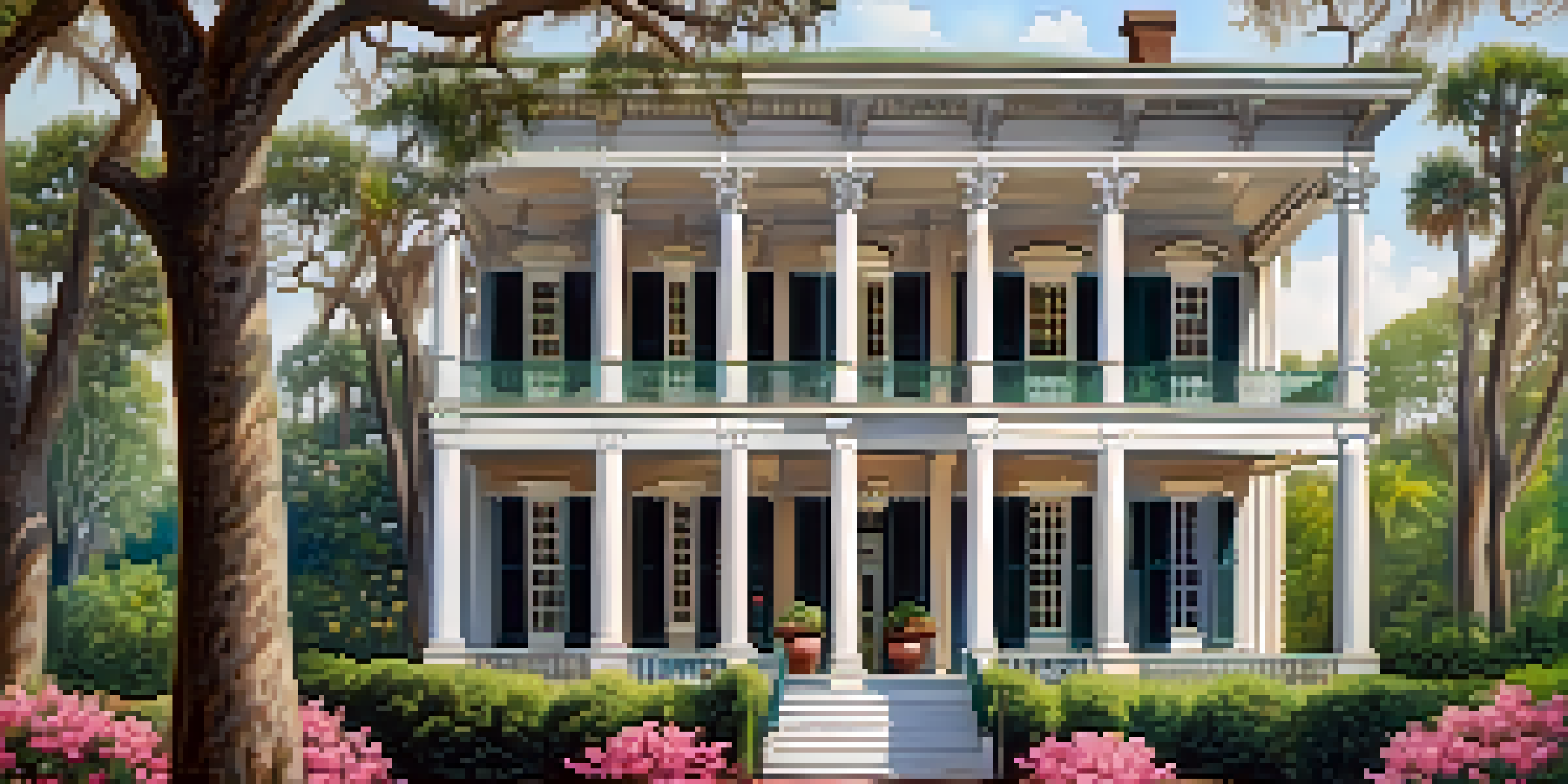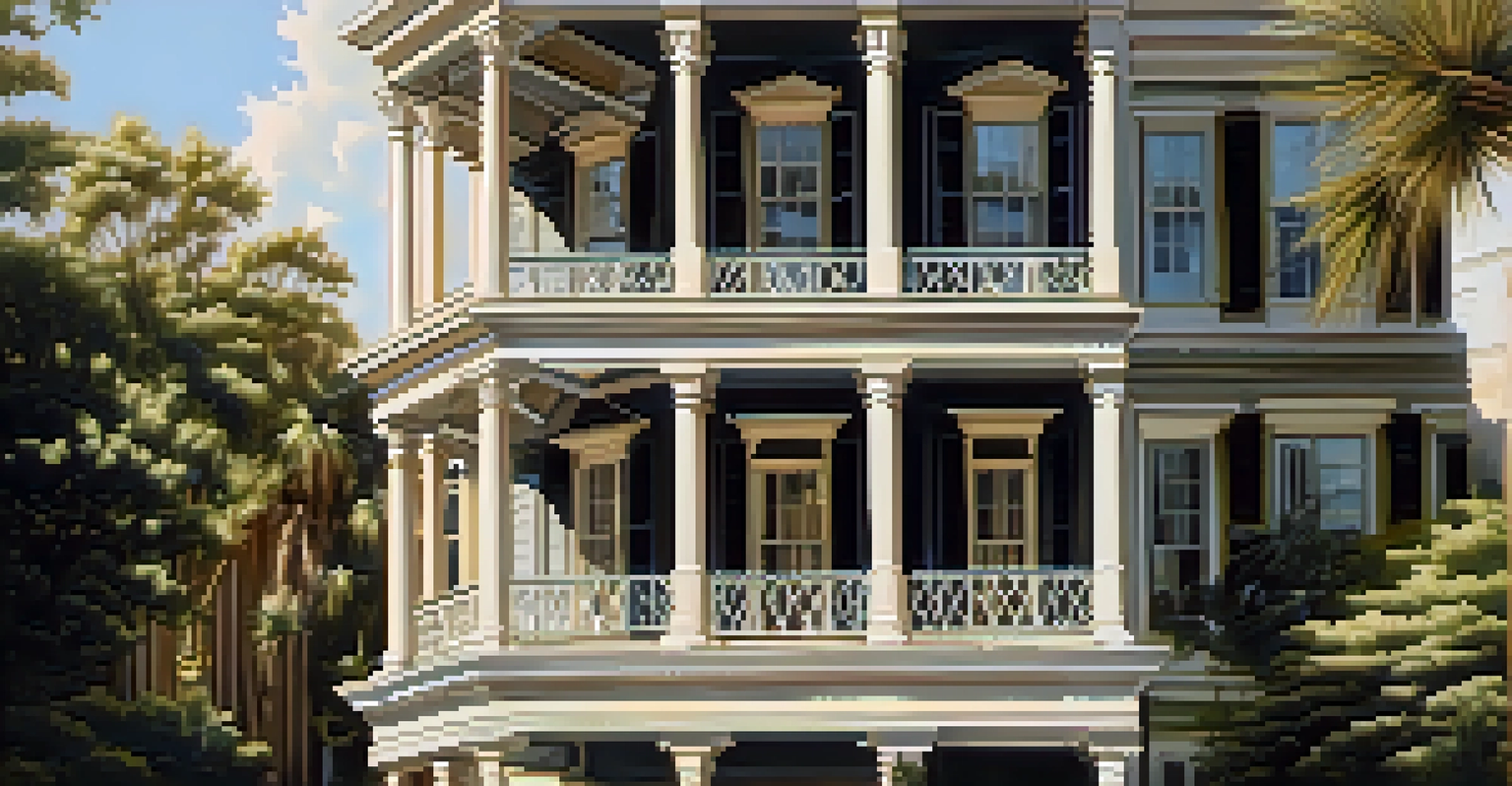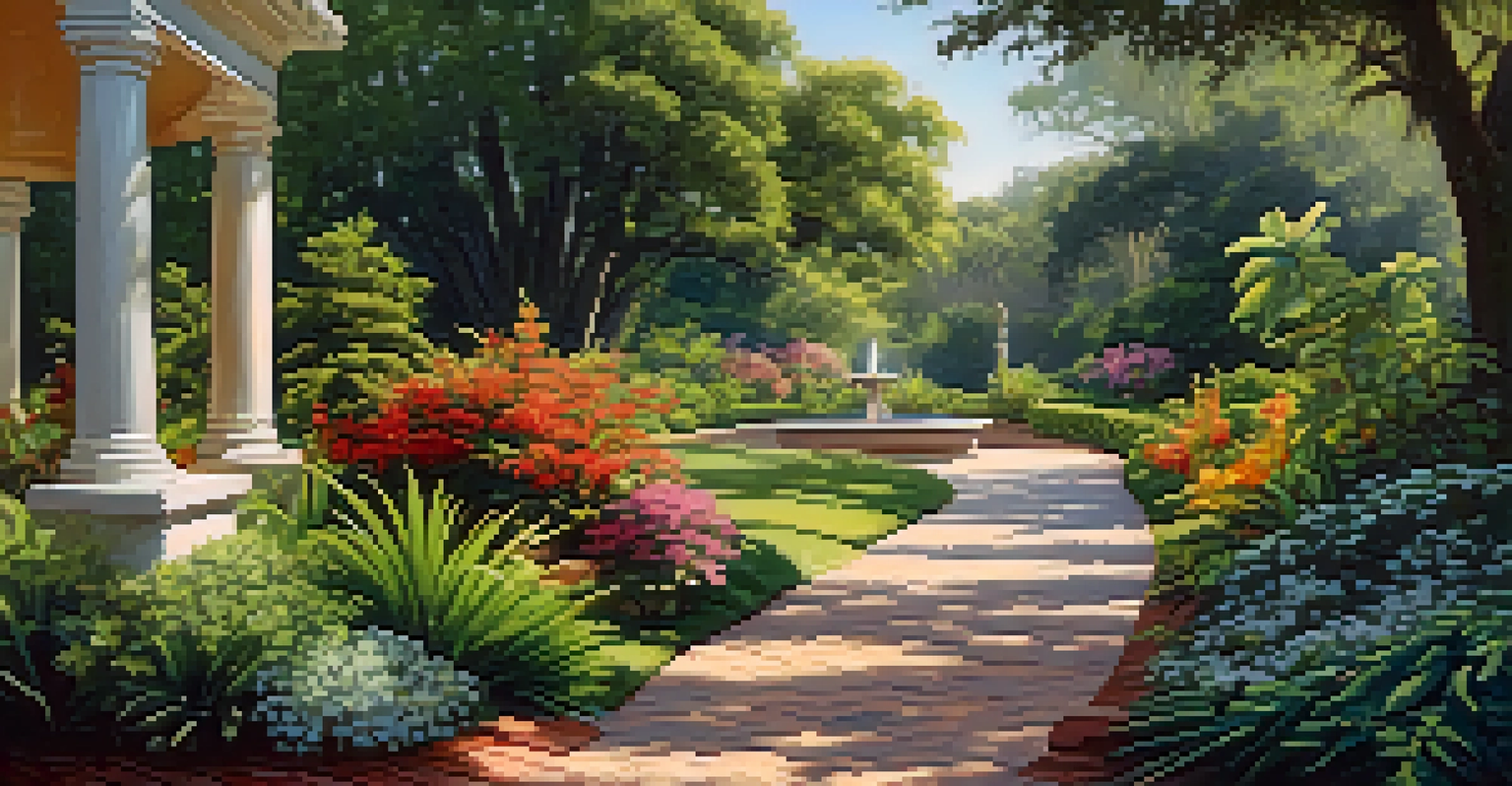Exploring Savannah's Antebellum Homes: A Journey Through Time

The Historical Significance of Antebellum Architecture
Antebellum architecture refers to the style of buildings constructed in the Southern United States before the Civil War. These homes often reflect the wealth and social status of their owners, showcasing intricate designs and craftsmanship. In Savannah, this style is not just a relic of the past, but a vital piece of the city’s identity, providing a window into its rich history.
Architecture is a visual art, and the buildings speak for themselves.
Many antebellum homes in Savannah were built using local materials, like tabby concrete, which gives them a unique character. The use of spacious porches and large windows was not only for aesthetic appeal but also for practical reasons, such as keeping the homes cool in the humid Southern climate. Walking through Savannah, you’ll see how these architectural choices tell a story of adaptation and elegance.
Understanding the significance of these homes allows visitors to appreciate not only their beauty but also the historical context behind them. Each house has its own narrative, shaped by the families who lived there and the events that unfolded in the city. This historical backdrop enriches the experience of exploring Savannah’s antebellum homes.
Key Features of Savannah's Antebellum Homes
Savannah's antebellum homes are characterized by their stunning architectural details, including grand columns, expansive verandas, and intricate moldings. These elements were often inspired by classical architecture, reflecting the aspirations of their owners to create a sense of grandeur. For instance, the impressive Greek Revival style can be seen in many of Savannah's most notable homes.

Another striking feature is the use of symmetry in design, which creates a sense of balance and harmony. Many homes were built with a central hallway that leads to various rooms, allowing for both functionality and elegance. This design not only enhances the beauty of the homes but also promotes ventilation and natural light, essential in the warm Southern climate.
Significance of Antebellum Homes
Antebellum homes in Savannah are vital historical landmarks that reflect the city's rich heritage and architectural beauty.
Additionally, you’ll notice the lush gardens that often accompany these homes, showcasing a blend of native and exotic plants. These gardens are not just for aesthetics; they were designed to create a serene environment and often served as spaces for social gatherings. Together, these features create a picturesque setting that transports visitors back in time.
A Walk Through Historic District: Notable Homes to Visit
As you stroll through Savannah's Historic District, several antebellum homes stand out, each with its own unique charm. The Mercer-Williams House, for example, is a stunning representation of Italianate architecture and has fascinating stories tied to its past. Visitors are often captivated by both its beauty and its intriguing history, which is vividly depicted in the book 'Midnight in the Garden of Good and Evil.'
History is not a burden on the memory but an illumination of the soul.
Another must-see is the Owens-Thomas House, known for its exquisite design and lush gardens. This home offers guided tours that delve into the lives of its former residents and the architectural significance of the house itself. Walking through its rooms, you can practically feel the echoes of the past, making it a highlight of any visit.
Lastly, don’t miss the Juliet Gordon Low Birthplace, which showcases the evolution of antebellum architecture over the years. As the founder of the Girl Scouts, Low's home has been preserved to reflect both her legacy and the architectural style of her time. Each of these homes invites visitors to step back in time and experience Savannah's rich heritage firsthand.
The Role of Antebellum Homes in Savannah's Culture
Antebellum homes are not just historical buildings; they play a vital role in Savannah's culture and community. They serve as venues for cultural events, weddings, and educational programs, bringing history to life for both locals and tourists alike. These homes are often featured in local festivals, showcasing the city’s commitment to preserving its heritage.
Moreover, many of these homes are maintained by historical societies and organizations dedicated to education and preservation. They often host tours and workshops that engage the community and raise awareness about the importance of architectural preservation. This involvement helps foster a deeper appreciation for Savannah's history among residents and visitors.
Cultural Role in Community Life
These homes serve as venues for cultural events and educational programs, fostering community engagement and appreciation for local history.
The cultural significance of these homes extends beyond their walls; they are integral to Savannah’s identity. The stories of the families who lived there, the events that transpired within, and the architectural beauty all contribute to a rich tapestry that defines the city. By exploring these homes, visitors gain a greater understanding of the cultural heritage that shapes Savannah today.
Exploring the Gardens: Nature's Beauty in Antebellum Homes
The gardens surrounding Savannah’s antebellum homes are as enchanting as the houses themselves. Often designed to complement the architecture, these gardens feature a mix of native plants and exotic species brought in by affluent homeowners. This blend not only adds to the beauty of the estates but also tells a story of exploration and botany in the region.
Many gardens were designed as places for relaxation and social gatherings, featuring paths, fountains, and lush greenery. As you wander through these outdoor spaces, you can imagine the families enjoying leisurely afternoons under the shade of magnolia trees or hosting grand parties amidst blooming azaleas. This connection to nature enhances the overall experience of visiting these historic homes.
Additionally, the preservation of these gardens is crucial for maintaining the historical integrity of the homes. Many organizations work diligently to restore and care for these landscapes, ensuring that future generations can appreciate their beauty. Exploring these gardens offers a unique perspective on the lifestyle of the past, making it an essential part of the antebellum experience in Savannah.
Visiting Tips: Making the Most of Your Antebellum Experience
When planning your visit to Savannah’s antebellum homes, timing is everything. Many homes offer guided tours, which are often more enjoyable and informative than self-guided visits. It’s a good idea to check the schedule in advance and consider visiting during the off-peak seasons to avoid crowds and get a more intimate experience.
Don’t forget to wear comfortable shoes, as exploring these historic neighborhoods often involves a fair amount of walking. The cobblestone streets and uneven pathways can be charming but also a bit tricky. Plan to take your time, allowing for spontaneous stops to appreciate the architecture and gardens along the way.
Preservation Efforts for the Future
Ongoing preservation initiatives are crucial to maintaining Savannah's antebellum architecture amid challenges like urban development and climate change.
Lastly, bring a camera! The picturesque settings of Savannah’s antebellum homes create perfect photo opportunities. Documenting your experience not only preserves your memories but also allows you to share the beauty of Savannah with friends and family. With these tips in hand, you’re ready to dive into the rich history of Savannah’s antebellum homes.
The Future of Savannah's Antebellum Homes
As we look to the future, the preservation of Savannah’s antebellum homes remains a priority for the city and its residents. Efforts are underway to ensure that these architectural treasures are maintained for future generations to enjoy. This includes funding for restoration projects and educational programs that highlight the importance of historical preservation.
However, challenges do exist, such as the threat of urban development and climate change, which can impact these historic structures. Community involvement and awareness are crucial in addressing these issues. Local organizations are actively engaging residents and encouraging them to participate in preservation efforts, fostering a sense of shared responsibility.

Ultimately, the future of Savannah’s antebellum homes lies in a delicate balance between honoring the past and embracing the future. By recognizing their historical significance and continuing to promote education and preservation, Savannah can ensure that these homes remain a cherished part of its cultural landscape for years to come.